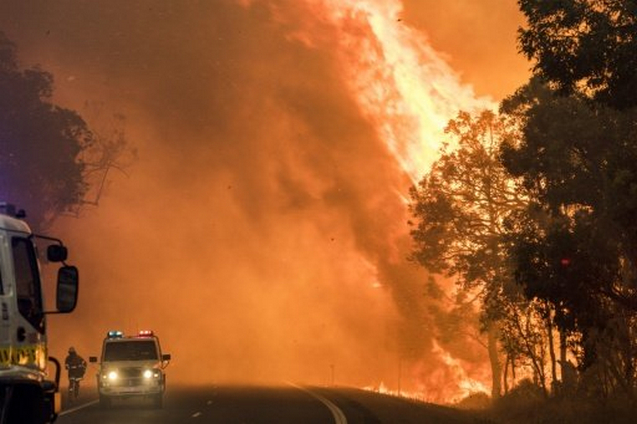SYDNEY (AFP) - "A sunburnt country... with a pitiless blue sky", so the famous poem goes, but where once Australia could rely on "steady, soaking rain", a trend of hotter and drier weather as the climate warms is making it more vulnerable to severe bushfires.
Climate experts warn that with rising temperatures, as well as decreasing rainfall in the south, parts of Australia are so dry the risk of bushfires is rising.
Since November huge swathes of the country have been scorched by ferocious blazes, leaving a total of nine dead and hundreds of homes destroyed. In South Australia, locals told of an "Armageddon-like" inferno sweeping through some areas, while in Western Australia bushfires raged out of control in a situation residents described as "like hell".
Already this year there have been scores more bushfires -- a recent incident at Yarloop, 110 kilometres (70 miles) south of Perth, left two dead.
 |
| A Department of Fire and Emergency Services photo shows a bushfire burning near Waroona, south of Perth, Australia on January 7, 2016. © Department of Fire and Emergency/AFP/File / by Glenda Kwek | |
Firefighters warn they are facing more intense, erratic blazes.
"From my experience, fires appear to be getting more intense, harder to fight, harder to plan for... and this is having an impact on firefighting strategies," Darin Sullivan, a 25-year veteran New South Wales state firefighter, told AFP.
Three of the five hottest years on record in Australia have occurred in the last three years, according to data compiled by the Bureau of Meteorology (BOM).
In 2013, Australia experienced its warmest year on record, 2014 was the third-hottest while last year was the fifth-warmest.
"Studies have shown an increase in the number of days with high levels of fire danger in southern and eastern Australia," BOM climatologist Blair Trewin told AFP.
"One of the things that is apparent is a lengthening of the fire season, so we're seeing more high fire danger days in spring and autumn, as well as in the core of summer."
'Catastrophic fires'
Bushfires are common in Australia's arid summer, which usually begins in December. Former prime minister Tony Abbott, a long-time climate change sceptic, said during the sweltering 2013-14 summer season that the heat was "just part and parcel of life in Australia".
"Australia is, to use the famous phrase, a land of droughts and flooding rains," he added, recalling the well-known Dorothea Mackellar poem "My Country".
But firefighter Sullivan said he and his colleagues were witnessing deteriorating conditions, including an apparent increase in the number of the most severe fires in recent years.
The "catastrophic" category in fire ratings was introduced after Victoria state endured the devastating "Black Saturday" bushfires in 2009 that left 173 dead in Australia's worst natural disaster.
Another issue exacerbating the impact of bushfires is that more and bigger buildings are being built in disaster-prone areas, with Campbell Fuller of Insurance Council Australia adding that often the properties being constructed were not resilient to extreme weather events.
An increase in the number and intensity of blazes is predicted to have a serious economic impact. Bushfires were estimated to have cost Australia US$247 million in 2014, but this is forecast to soar to US$548 million by 2050, according to Deloitte Access Economics, which cited population growth and infrastructure density as factors.
'Increasing danger'
Ken Mansbridge, whose family home was burnt down in the 1983 Ash Wednesday bushfires that killed more than 70 people in Victoria and adjacent South Australia, continues to live in the same region and has noticed a stark difference in weather patterns.
"There's definitely a noticeable change in the weather patterns and in the actual vegetation... I've never seen the local area look as dry as it does," the 70-year-old retiree, who has lived in the Macedon Ranges about 70 kilometres northwest of Melbourne for more than four decades, told AFP.
"The trees are all flowering at different times, the vegetables this year were all wind and sun burnt," he explained.
A November report by the independent Climate Council pointed to longer bushfire seasons across the globe.
"What climate change is doing is loading the dice towards having the sort of conditions that are conducive to fires spreading and being very hot and more uncontrollable," said lead author Lesley Hughes, a Macquarie University biologist and ecologist.
With the BOM and national science body CSIRO expecting Australia to "warm substantially" this century, having already seen temperatures rise approximately 1.0 degree Celsius (1.8 degrees Fahrenheit) since 1950, Sullivan said strategies for fighting fires needed to be overhauled and climate change addressed.
"If this type of intensity and increase continues, then our resources are very close to being overrun at times," he said.
"This is our workplace. When we go to work to fight fires, our workplace is now more dangerous because of climate change as well."


No comments:
Post a Comment